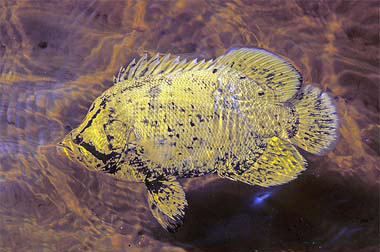
Lobotes surinamensis
This flat, almond-shaped fish has large, round dorsal and anal fins that match the caudal (tail) fin, giving it its ‘tripletail’ name. It has a triangular head, and as it ages, the forehead grows more dramatically concave. It’s a coastal tropical fish that prefers a solitary habitat, choosing to float near shipwrecks, sea buoys, and pilings of jetties, or in the open water it finds debris other floating cover to hide near.
Order – Perciformes
Family – Lobotidae
Genus – Lobotes
Species – surinamensis
Common Names
English language common names are Atlantic tripletail, black grunt, black perch, bouyfish, conchy leaf, dusky tripletail, dusky triple-tail, flasher, sleepfish, triple tail, tripletail, and triple-tail. Other common names include bekuku (Javanese), berrugate (Spanish), berrugato (Spanish), biajaca de la mar (Spanish), biajaca de mar (Spanish), cabeh watu (Javanese), chobie (French), colo-colo (Portuguese), croupia roche, dormeur, dormilona (Spanish), driestert (Afrikaans), faumer (Tobian), furriel (Portuguese), ikan tidur (Malay), jalow (Somali), kakap bato (Tagalog) kakap telessi (Javanese), kanda (Swahili), kohoa dale (Gela), kuku laut (Malay), Lobotes (Portuguese), lovopsaro (Greek), macuri (Spanish), matsudai (Japanese), mayimen (Carolinian), musalli (Sinalese), nyeng-nyeng (Makassarese), papoena (Sranan), pargee (Spanish), pechah periok (Malay), peixe-folha (Portuguese), pelak watu (Javanese), pelayak (Malay), pesce foglia (Italian), phargee (Spanish), prejereba (Portuguese), samudra koi (Bengali), sekusong (Malay), sepat karang (Malay), sung-sung (Malay), tchintchin de fundo (Portuguese), tres colitis (Spanish), trójchwoscik lobotes (Polish), and viuda dormilona (Spanish).
Importance to Humans
A few tons of tripletails are fished commercially on the east and west coasts of Florida, and marketed fresh, frozen, or salted. They are mainly caught using haul seines, gill nets and line gear. They are common in driftnet catches of tuna along the edge of the continental shelf. This fish is infrequently targeted by recreational fishers.
Conservation
The tripletail is not listed as endangered or vulnerable with the World Conservation Union (IUCN). The IUCN is a global union of states, governmental agencies, and non-governmental organizations in a partnership that assesses the conservation status of species.
> Check the status of the tripletail at the IUCN website.
Geographical Distribution
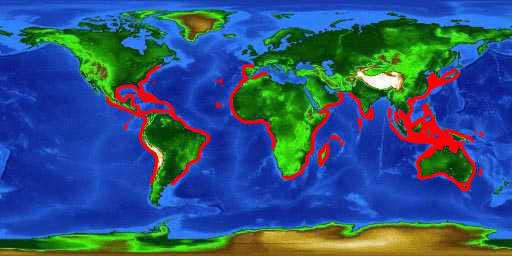
The tripletail is found from Massachusetts and Bermuda to Argentina, including both the Gulf of Mexico and the Caribbean Sea. It is also found in the eastern Atlantic: Mediterranean Sea as well as from Madeira Island (Portugal) to the Gulf of Guinea, Eastern Pacific: Costa Rica to Peru, and the Western Pacific: Japan, Fiji, and Tuvalu as well as in the tropical and subtropical waters surrounding Australia. It is rare north of the Chesapeake Bay. They are found on the Gulf coast April through early October and migrate to the south during the winter months. There has been one report of a tripletail caught off the coast of California. The tripletail is not very abundant in any particular location.
Habitat
The tripletail is found coastally in most tropical and subtropical seas. The tripletail is a semi-migratory pelagic fish. It is normally solitary, but under some conditions the tripletail may form schools. In the summer, they can be found in bays, sounds and estuaries. Juveniles are often found swimming under patches of Sargassum algae. Adults are normally found in waters of the Gulf of Mexico, but may occur in passes, inlets, and bays near river mouths. The tripletail is often found around ship wrecks, supports of beacons, the pilings of jetties, and sea buoys. Tripletail larvae are usually found in waters greater than 84°F (28.8°C), greater than 30.3 ppt salinity and more than 230 feet (70 m) deep. The tripletail is the only member of its family Lobotidae found in the Atlantic Ocean.
Biology
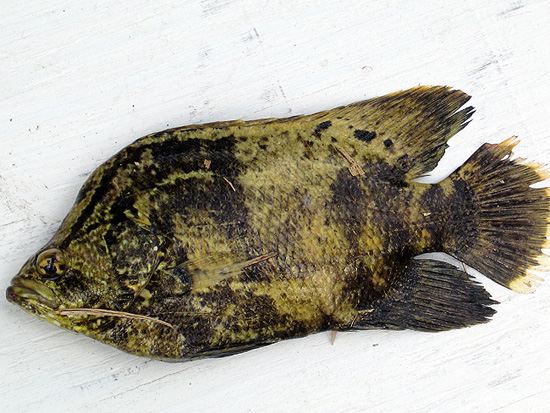
Distinctive Features
Tripletails have small scales extending onto the dorsal, caudal and anal fins and a head profile which becomes more concave with age. The tripletail has a compressed and deep body, with a triangular-shaped head. The eyes are relatively small, and its mouth is large. The bases of both its dorsal and anal fins are scaled, and its pectoral fins are shorter than its pelvic fins. The tripletail has distinctively large and rounded soft dorsal, caudal, and anal fins. This characteristic gave rise to the common name.
Coloration
The juveniles are mottled with yellow, brown and black. Lying on its side at the water surface, a young tripletail looks like a floating mangrove leaf. The juveniles have white pectoral fins and a white margin on the caudal fin. Adult tripletails have varied mottled color patterns, ranging from dark brown to a reddish brown or brown with a tint of gray.
Dentition
The tripletail has no teeth on the vomer and palatine.
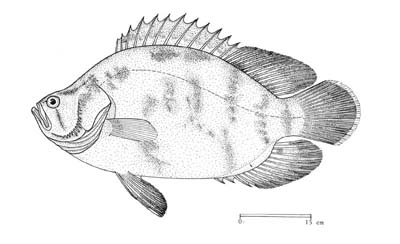
Size, Age, and Growth
The tripletail grows to 35 inches (89 cm) in length and a weight of 41 pounds (18.6 kg ). However, the average weight is between 2.2 and 15.4 pounds (1-7 kg). The tripletail grows fastest in its first year. This may be an adaptation to the high predation rate of small fishes in the epipelagic zone. The transition from a larval tripletail to a juvenile occurs between 0.35-0.37 inches (9.0-9.5 mm) in standard length.
Food Habits
The tripletail is opportunistic, feeding on a variety of prey including small finfish such as gulf menhaden (Brevoortia patronus), Atlantic bumper (Chloroscombrus chrysurus)and anchovies (Anchoa spp.). Invertebrate prey include blue crabs (Callinectes sapidus) and brown shrimp (Farfantepenaeus aztecus), as well as many other benthic crustaceans.
Reproduction
Spawning primarily occurs in the summer along both the Atlantic and the U.S. Gulf of Mexico coasts, with peaks during the months of July and August. Larval tripletails go though four levels of development; preflexion, flexion, postflexion, and transformation. By the time the larva reach 0.16 inches (4.0 mm), they have large eyes and a concave head. The larval forms of tripletail resemble those of boar fishes, some jacks, spade fishes and bigeyes.
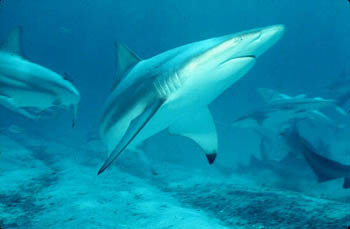
Predators
The tripletail does not have many predators, however, mainly sharks and larger teleosts feed on this fish.
Parasites
Parasites of the tripletail include the copepods Anuretes heckelii which is found on the wall of the branchial cavities and Lernanthropus pupa that is parasitic on the gill filaments. Another known parasite of the tripletail is Scianophilus tenius.
Taxonomy
The tripletail was first described by Bloch as Holocentrus surinamensis in 1790. Later in 1790, the tripletail was referred to by Bloch as Lobotes surinamensis, the name still in use today. The genus name Lobotes is translated from the Latin word “lobus” as lobe. The tripletail was given its species name because it was discovered in Surinam, in northern South America. It has appeared in literature under a variety of synonyms. Although these names are no longer valid, they included Bodianus triourus Bloch 1790, Lobotes erate Cuvier 1830, Lobotes farkharii Cuvier 1830, Lobotes somnolentus Cuvier 1830, Lobotes citrinus Richardson 1846, Lobotes incurvus Richardson 1846, Lobotes auctorum Gunther 1859, Labotes pacificus Gilbert 1898, and Lobotes pacificus Gilbert 1898.
Prepared by: Tina Perrotta